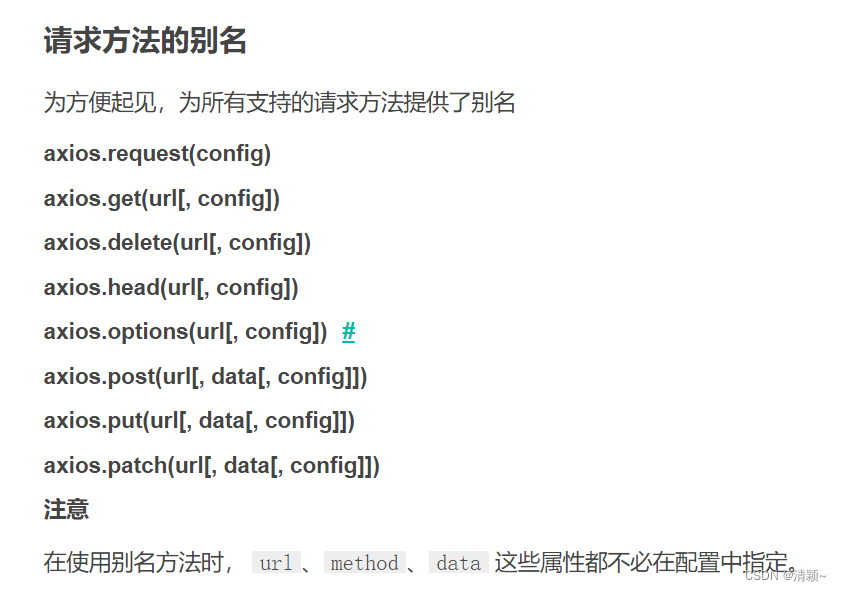热门标签
热门文章
- 1电路基础_模拟电路_问答_2023_01_1、利用 lcr 自动测量仪测量硅三极管和锗三极管的bc结和be结静态电容。2、利
- 2VC图像编程_setdibitstodevice显示网格线
- 3[Leetcode 136][Easy]-只出现一次的数字
- 4技术人怎么开始写博客和运营公众号_微信订阅号写技术博客
- 5探索编程艺术之门:HackerRank解决方案全景指南
- 6银行信息系统应用架构导论-目录_银行信息系统应用架构导论 电子版
- 7[数据结构]:17-双链表(带头结点)(C语言实现)_带头结点头文件c语言
- 8卷麻了,00后测试用例写的比我还好,简直无地自容...
- 9SQL中的CASE WHEN语句:从基础到高级应用指南_sql case when语句
- 102024年微信小程序学习笔记(二)-- 开发之框架_微信小程序开发框架,2024年最新网络安全黑科技保活实现原理揭秘
当前位置: article > 正文
前端热门技术axios详细讲解(一)——基本使用方法_前端axios的使用
作者:Li_阴宅 | 2024-07-03 17:46:43
赞
踩
前端axios的使用
前言:
axios 作为前端必学技术,它实质上是一个基于XMLHttpRequest和 promise 的 HTTP 库,Vue和React都推荐使用它发送ajax请求。
本文主要讲述axios发送请求时要掌握的知识点。
一、axios的特点
- 在浏览器和node中都可以使用
- 支持 Promise API
- 可以拦截请求、响应
- 转换请求数据、响应数据
- 取消请求
- 自动转换 JSON 数据
- 客户端支持防御 XSRF
传送门:点击这里到github
二、使用方法
在项目中安装:
$ npm install axios
- 1
或
$ yarn add axios
- 1
使用cdn:
<script src="https://unpkg.com/axios/dist/axios.min.js"></script>
- 1
1. 默认配置
我们可以给axios设置一个默认的基本配置,里面包括 url、method 等,设置好之后就不用每次添加了。(只有 url 是必需的,如果没有指定 method,请求将默认使用 get 方法。)
axios.defaults.baseURL = 'https://api.example.com';
axios.defaults.headers.common['Authorization'] = AUTH_TOKEN;
axios.defaults.headers.post['Content-Type'] = 'application/x-www-form-urlencoded';
- 1
- 2
- 3
2. 自定义全局配置
// 设置配置对象
const configOptions={
baseURL: 'https://api.example.com',
timeout:30000, // 超时取消请求
withCredentials: true, // 表示跨域请求时是否需要使用凭证,默认false
}
//创建实例时,传入配置
const instance = axios.create(configOptions);
// 实例创建后更改默认值
axios.defaults.headers.post['Content-Type'] = 'application/x-www-form-urlencoded';
- 1
- 2
- 3
- 4
- 5
- 6
- 7
- 8
- 9
- 10
- 11
- 12
注意:配置是有优先级的,这个顺序是:在 lib/defaults.js 找到的库的默认值 < 是实例的 defaults 属性 < 请求的 config 参数。后者将优先于前者。
3. 请求配置
{ // `url` 是用于请求的服务器 URL url: '/user', // `method` 是创建请求时使用的方法 method: 'get', // default // `baseURL` 将自动加在 `url` 前面,除非 `url` 是一个绝对 URL。 // 它可以通过设置一个 `baseURL` 便于为 axios 实例的方法传递相对 URL baseURL: 'https://some-domain.com/api/', /* `transformRequest`:向服务器发送前,修改请求数据; 只能用在 'PUT', 'POST' 和 'PATCH' 这几个请求方法; 后面数组中的函数必须返回一个字符串,或 ArrayBuffer,或 Stream */ transformRequest: [function (data, headers) { // 对 data 进行任意转换处理 return data; }], // `transformResponse` 在传递给 then/catch 前,修改响应数据 transformResponse: [function (data) { // 对 data 进行任意转换处理 return data; }], }
- 1
- 2
- 3
- 4
- 5
- 6
- 7
- 8
- 9
- 10
- 11
- 12
- 13
- 14
- 15
- 16
- 17
- 18
- 19
- 20
- 21
官方为了方便起见,给axios的常用方法专门起了别名,可以直接像这样使用:axios.get(),axios.post(),axois.put()等等。如图:

这里只介绍基本的,更多详细内容请点击这里。
4. 发送get请求
get 请求传参可以直接加在地址后,或写在params对象中。
const axios = require('axios').default; // 第一种:直接加在地址后,用问号?传参 axios.get('/user?ID=12345') .then(function (response) { console.log(response); }) .catch(function (error) { console.log(error); }) .then(function () { // always executed }); // 第二种:在花括号中用params对象传参 axios.get('/user', { params: { ID: 12345 } }) // Want to use async/await? Add the `async` keyword to your outer function/method. async function getUser() { try { const response = await axios.get('/user?ID=12345'); console.log(response); } catch (error) { console.error(error); } }
- 1
- 2
- 3
- 4
- 5
- 6
- 7
- 8
- 9
- 10
- 11
- 12
- 13
- 14
- 15
- 16
- 17
- 18
- 19
- 20
- 21
- 22
- 23
- 24
- 25
- 26
- 27
- 28
5. 发送post请求
axios.post('/user', {
firstName: 'Fred',
lastName: 'Flintstone'
})
.then(function (response) {
console.log(response);
})
.catch(function (error) {
console.log(error);
});
- 1
- 2
- 3
- 4
- 5
- 6
- 7
- 8
- 9
- 10
声明:本文内容由网友自发贡献,不代表【wpsshop博客】立场,版权归原作者所有,本站不承担相应法律责任。如您发现有侵权的内容,请联系我们。转载请注明出处:https://www.wpsshop.cn/w/Li_阴宅/article/detail/784024
推荐阅读
相关标签




